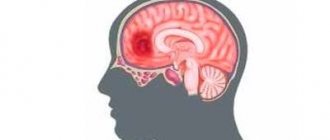As a rule, atheroma occurs in those places where hair is developed. Therefore, the head, rich in sebaceous ducts, often acts as their incubator.
Atheroma on the head is caused by blockage of the sebaceous glands. The reasons are different - for example, as a consequence of injury or against the background of hormonal imbalance.
However, there is another reason. Remember the words of the heroine Ekaterina Vasilyeva from the movie “An Ordinary Miracle”: “What the hell do I need my head for when it hasn’t been washed for three days?” - she asks rightly. Yes, atheroma of the scalp can also occur due to the banal inability to keep hair clean.
Atheroma of the scalp can be congenital. This is a rare case when it can remain unchanged for many years. Or it may be acquired. Such atheroma occurs at any age and can literally grow from the size of a pea to the size of a chicken egg in just a matter of days.
!
In any case, atheroma is a disease that requires the attention of a doctor. And the sooner the better.
Firstly, the signs of atheroma are very similar to the symptoms of another neoplasm - lipoma; often only a professional diagnostician can distinguish them.
Secondly, a bump on the head attracts a lot of unhealthy attention.
In addition, a rapidly growing large atheroma resembles a cerebral hernia (brain prolapse). So, as is the case with any neoplasms, you cannot wait, nothing itself will ever resolve
!
Reasons for development
Factors contributing to the development of atheroma on the head are:
- metabolic disorders leading to changes in the properties of the secretion of the sebaceous glands;
- hair dyeing, head shaving with damage to hair follicles;
- hyperhidrosis (especially in combination with seborrheic dermatitis);
- inflammatory diseases of the scalp;
- low-quality hygiene products for hair care;
- Irregular hair washing with the accumulation of viscous oil on the scalp.
Atheromas often form not only on the scalp, but also around the ears and on the chin.
What is atheroma
Simply put, atheroma is a soft bump on the head, usually yellow in color. Both isolated cases of atheroma development and atheromatosis, in which frequent relapses occur, are possible.
In Buddhism, the bulge on the top of the head is a symbol of enlightenment, which is always present in images of Buddha. In real life, things are a little different. If the atheroma is not removed in time, sooner or later it will become inflamed and suppurate. Its symptoms are as follows: when the atheroma is inflamed, it begins to change color to light brown, a “bump” breaks through, and pus is released from it. All this is accompanied by an indescribable aroma, faintly similar to the blooming of a spring meadow.
Naturally, like any purulent process, when atheroma suppurates, immediate surgical intervention is required. But it is better to go to the doctor without waiting for such developments.
Expert comment:
“Bringing atheroma to inflammation is not worth it for many reasons.
Firstly, to treat purulent wounds, the surgeon is forced to make a large incision in order to properly clean them.
Secondly, as a result of excess inflammation, an unsightly keloid scar can form.
So the operation to remove atheroma, when the atheroma is calm, is much easier and requires almost no time for rehabilitation.”
Maxim Vasiliev, plastic surgeon.
Clinical picture
The cyst is a soft lump with rounded contours, located subcutaneously. Even small atheromas are clearly visible if you part your hair and carefully examine the changed skin.
Non-inflammatory atheromas are painless and do not cause discomfort, but if an infection occurs (which almost always happens with an accidental injury), the symptoms become more obvious. Suppuration of the cyst leads to its increase in size, intense pain, redness of the skin, and local swelling. The skin in the area of the inflamed atheroma is hot, and pus may be released from the outlet of the sebaceous duct.
Removal of papillomas on the head in dermatology
Any formations, even large ones, can be removed quickly, painlessly and safely.
Benefits of physical removal:
- instant and guaranteed effect
- formations can be removed in any quantity, of any size
- there is no risk of damage to surrounding tissues if the procedure is carried out correctly
- no pain thanks to anesthesia
- good aesthetic effect
Cryodestruction
Liquid nitrogen is a classic way to remove papillomas.
It has a number of advantages:
- simplicity
- rapidity
- no anesthesia needed
- efficiency
- formations of any localization can be removed
- low price
But there are a number of disadvantages.
After liquid nitrogen, an inflammatory reaction often occurs in the affected area, which is fraught with pain.
Only small formations can be removed.
When trying to remove large papillomas, it is necessary to increase the exposure time to liquid nitrogen, which can result in the appearance of scars.
In addition, there is no material left for histological examination.
Laser
Laser removal of papilloma on the head is becoming increasingly popular.
The method has many advantages:
- no bleeding due to vascular coagulation
- there are no infectious complications, since the laser destroys bacteria
- accelerated tissue healing
But there are also disadvantages.
Only small papillomas can be removed (although larger than when using liquid nitrogen).
They do not separate from the body, but are destroyed.
Laser vaporization involves evaporation of the formation.
They usually do not work in laser cutting mode.
Because after it the tissues do not grow well together (a dense scab forms on the surface).
As with removal with liquid nitrogen, there is no material left that could be sent for histological examination to exclude malignant degeneration.
Electrocoagulation
The method uses electricity to heat tissue.
Electrocoagulation works in both cutting and coagulation (resolution) modes.
Advantages of the method:
- even a large papilloma on the head can be removed
- instant sealing of blood vessels and elimination of bleeding
Flaws:
- Wounds take longer to heal than after laser
- sometimes scars appear
Electrocoagulation is more suitable for removing formations that rise above the skin level.
They can be separated from the body and sent for histological examination.
Radio wave method
The radio wave method is the same as electrocoagulation, only electromagnetic waves have a high frequency.
This is a more advanced removal method.
Papillomas of any size can be eliminated.
Wounds after radio waves are sterile and heal quickly.
If necessary, they can be sutured, as after dissection with a scalpel.
This improves aesthetic results when removing large papillomas.
Treatment
The most effective way to remove atheromas with minimal risk of recurrence is radio wave excision using the Surgitron device (USA). The procedure does not require shaving the hair; removal takes place under local anesthesia in 30 minutes. Bleeding does not occur due to instant coagulation of blood vessels. The scalp and hair are not damaged. Removal of the formation is non-contact; after the procedure, the doctor carries out an antiseptic treatment and a follow-up examination of the patient. The procedure is outpatient and does not require hospitalization.
Types of neoplasms on the scalp and neck
The most common include: They have different forms and causes. Therefore, each type has its own approach to treatment.
Nevus on the skin of the face, head
There are different types of nesus, which are classified into two groups: melanocytic (formed from pigment cells, melanocytes) and non-melanocytic (formed from other cells). Most skin nevi on the face , head and neck are not prone to degeneration into a malignant tumor. However, there are atypical nevi that have the characteristics of melanoma. However, their difference from a malignant neoplasm is stability, preservation of shape and size, and lack of growth. There is a distinction between congenital and acquired dermal nevus . The cause, as a rule, is a hereditary predisposition, as well as prolonged exposure to the sun. Removal of a nevus on the face and head is required in cases where it violates external aesthetics and is regularly damaged (for example, when washing your hair, during shaving and other procedures, as well as from accidental careless touching).
Skin keratoma on the face and head
pigment keratoma formation is a pathological accumulation of horny skin cells. With prolonged and regular exposure to sunlight, degenerative changes in cells occur. The neoplasm can be either single or multiple. The locations of keratoma are also different: cheeks , forehead, nose area, neck. Seborrheic keratoma usually appears on the scalp . In addition to the head and neck, the formation can appear in other parts of the body. Removal of keratoma on the face, head and neck is necessary in cases where it spoils the aesthetic appearance and is regularly injured. If the tumor is in an area that is not visible to others and does not cause any discomfort, regular monitoring is sufficient.
Papillomas on the neck and face
This type of neoplasm appears as a result of human infection with human papillomavirus (HPV). In this case, the virus can be in the human body, but not manifest itself in any way. Papillomas on the eyelids, head, under the eye, in the mouth and throat and other places appear for the following reasons:
- decreased immunity and protective functions of the body;
- hormonal disorders;
- the presence of severe forms of chronic diseases;
- exhaustion and/or hypothermia of the body.
There are also often cases where papillomas appear on the neck or in other places as a result of hormonal changes during pregnancy or after an abortion. Bad habits and an unbalanced diet can also become factors influencing the occurrence of formations. Externally, papillomas can have various shapes: round, flat, pointed (condyloma), thread-like and others. The localization location can also be any. In particular, papillomas often appear on the eyelid, tongue, palate and even in the throat. To remove a papilloma on your face, neck or mouth, make an appointment with our oral and maxillofacial surgeon.
Classification
Classification by tissue from which tumor formation occurs:
- Fatty – liposarcoma;
- Muscular:
- striated muscle tissue - rhabdomyosarcoma,
- unstriated muscle tissue – leiomyosarcoma;
- Vessels:
- circulatory – hemangiosarcoma,
- lymphatic – linfangiosarcoma;
- Connective – fibrosarcoma;
- Synovial membrane – synovial sarcoma;
- Nervous – neurogenic sarcoma;
- Skin – fibrosarcoma.
Seborrheic dermatitis: diet in adults
Compliance with special nutritional rules is an important addition to the main therapy. The basic rules are simple:
- exclusion of fatty and fried foods, spicy seasonings, smoked foods, sweets;
- increasing the share of fermented milk products, raw and processed vegetables and fruits;
- consumption of lean meat, poultry, fish;
- replacing animal fats with vegetable oils;
- fractional meals.
You should listen to your body and make adjustments to your diet if your skin condition worsens, excluding foods that cause a negative reaction from the menu.
The listed measures should in no way be taken as a guide to action. Seborrheic dermatitis should be treated only under the supervision of a dermatologist, who should be contacted immediately after the appearance of alarming symptoms. If the disease affects the scalp, you will need the help of a trichologist - a doctor specializing in hair treatment. Do not delay your visit to the clinic, because the sooner treatment is started, the faster your health will be restored.
Treatment of seborrheic dermatitis in adults
To get rid of the disease, you need to consult a dermatologist. After confirming the diagnosis, the doctor prescribes a comprehensive treatment, which is aimed both at reducing the clinical manifestations of the disease and at generally strengthening the body and eliminating the causes of the disease. Therapy usually includes:
- keratolytic ointments or compresses to remove crusts;
- antifungal agents;
- antibiotic ointments in case of secondary infection;
- antihistamines to eliminate bothersome itching;
- general strengthening vitamin complexes.
As an effective supplement, herbal decoctions, infusions and masks are often used, which reduce itching, help get rid of crusts, and have a wound-healing and soothing effect. In severe cases of the disease, ointments with corticosteroids are prescribed for a short time.
Autoimmune diseases: causes and methods of treatment
For healthy people, patients with psoriasis or scleroderma do not pose any threat; these diseases are associated with a deficiency of essential vitamins and minerals in the body. The patient must be protected from situations that cause depression, anxiety and stress, after which the doctor prescribes oral drug treatment, namely:
- take a course of medications with a high content of vitamins, amino acids and minerals necessary for the recovery of the body;
- sedatives (if the patient is unable to get rid of stress on his own).










